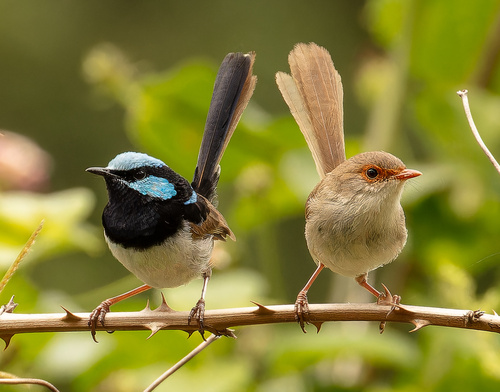
Superb Fairywren
The Superb Fairywren (*Malurus cyaneus*) is a small, charismatic bird renowned for its striking sexual dimorphism and complex social behaviors. It plays a vital role in the Australian ecosystem as an insectivore, helping to control insect populations. While not widely known in global popular culture, the Superb Fairywren is a beloved and frequently observed species within its range, often featured in Australian wildlife guides and documentaries. It represents a classic example of cooperative breeding in birds.
14 cm
Length
15-18 cm
Wingspan
Least Concern
Conservation Status
Distribution
Southeastern Australia, including Tasmania and some offshore islands. Ranges from southeastern Queensland through New South Wales and Victoria to southeastern South Australia.
Lifespan
Average lifespan in the wild is 4-6 years, but some individuals can live longer.
Superb Fairywren's Habitat
Habitat Types
Woodlands, Forests, Shrublands, Urban parks and gardens with dense undergrowth
Climate Zones
Temperate, Subtropical
Adaptations
Their small size and agility allow them to navigate dense vegetation effectively. They are adapted to a variety of habitats, provided there is sufficient low-lying cover for foraging and nesting.
Variations
Several subspecies are recognized, differing slightly in plumage color and size. For instance, Tasmanian birds tend to be slightly larger.
Appearance
Breeding Plumage
Breeding males are brilliant blue with black and grey-brown markings. Non-breeding males, females, and juveniles are predominantly brown with a dull blue tail.
Seasonal Feather Changes
Males molt into their bright breeding plumage before the breeding season and revert to a duller 'eclipse' plumage after breeding.
Sex Based Plumage Differences
Highly pronounced. Breeding males are strikingly different from the duller females and juveniles.
Notable Features
Bright blue crown and ear coverts in breeding males., Long, upright tail, often cocked., Short, rounded wings.
Diet and Feeding
Primary Foods
Insects, Spiders, Other small arthropods, Occasionally seeds
Foraging Behavior
Forages actively on the ground and in low vegetation, hopping and gleaning insects from leaves and the ground. Often forages in small groups.
Specializations
Their small, sharp beaks are well-suited for picking insects from foliage.
Seasonal Diet Variations
Diet is primarily insectivorous year-round, but may include a small amount of seeds during leaner periods.
Behavior
Social Structure
Live in family groups consisting of a dominant breeding pair and several helpers, which are usually offspring from previous years.
Communication
High-pitched, rapid calls, Complex songs used for territorial defense and communication within the group, Visual displays, including tail-flicking and wing-fluttering
Migration
Generally sedentary, but may make short-distance movements in response to food availability or habitat changes.
Territorial or Group Behaviors
Groups defend a territory year-round. Helpers assist in territorial defense and predator alarm calls.
Conservation
Threats
Habitat loss and fragmentation due to urbanization and agriculture, Predation by introduced species (e.g., cats, foxes), Increased frequency of intense bushfires
Protection Programs
Habitat restoration and management initiatives, Control programs for introduced predators, Community education programs
Local National Laws
Protected under state and national wildlife legislation in Australia.
Population Trend
Stable
Population Estimates
While widespread and relatively common, precise population estimates are difficult to obtain.
Interesting Facts
Superb Fairywrens are known for their cooperative breeding system.
This means that young birds often stay with their parents to help raise subsequent broods.
Males use petal-carrying as a courtship display.
They present brightly colored petals, often yellow, to females, potentially to demonstrate their fitness.
They exhibit high rates of extra-pair paternity.
Despite social monogamy, females often mate with males outside their social group.
Faqs about Superb Fairywren
What is the difference between a male and female Superb Fairywren?
Breeding males are bright blue and black, while females and non-breeding males are mostly brown.
Where can I see Superb Fairywrens?
They are common in southeastern Australia, often found in parks, gardens, and woodlands with dense undergrowth.
Are Superb Fairywrens endangered?
No, they are classified as Least Concern by the IUCN.
Copyright @ Nature Style Limited. All Rights Reserved.
 English
English